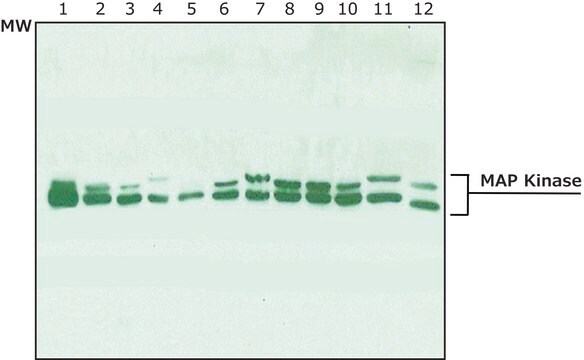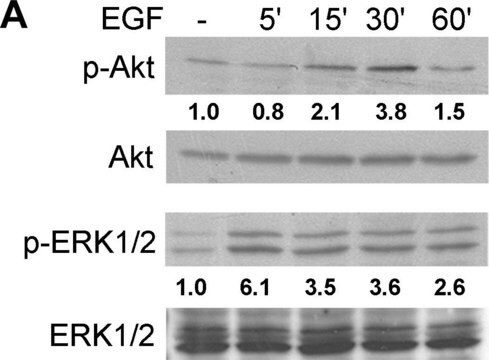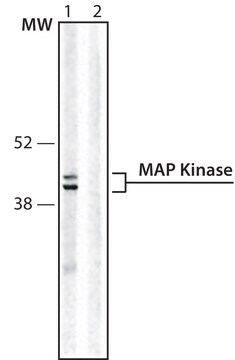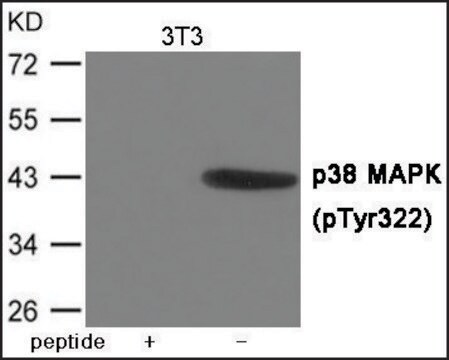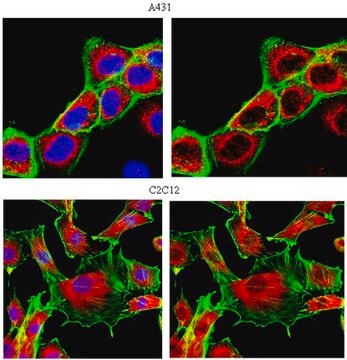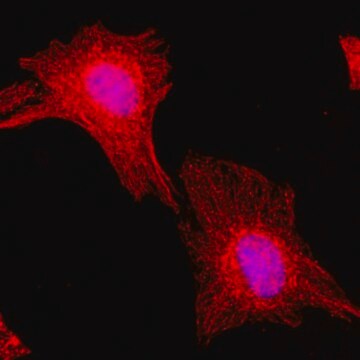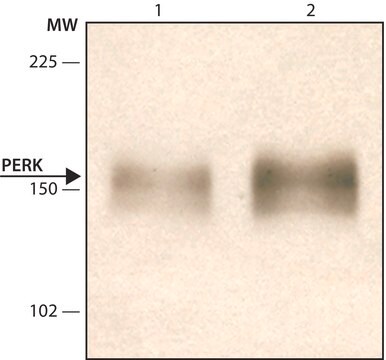M9692
Anti-MAP Kinase, Activated (Diphosphorylated ERK-1&2) antibody, Mouse monoclonal
clone MAPK-YT, purified from hybridoma cell culture
Synonyme(s) :
Monoclonal Anti-MAP Kinase, Activated (Diphosphorylated ERK-1&2)
About This Item
Produits recommandés
Source biologique
mouse
Niveau de qualité
Conjugué
unconjugated
Forme d'anticorps
purified immunoglobulin
Type de produit anticorps
primary antibodies
Clone
MAPK-YT, monoclonal
Forme
buffered aqueous solution
Poids mol.
antigen ERK-1 44 kDa
antigen ERK-2 42 kDa
Espèces réactives
human, Caenorhabditis elegans, Xenopus, Drosophila, hamster, rat, bovine, mouse, yeast
Conditionnement
antibody small pack of 25 μL
Concentration
1.5-2 mg/mL
Technique(s)
immunocytochemistry: suitable
immunohistochemistry (formalin-fixed, paraffin-embedded sections): suitable
immunoprecipitation (IP): suitable
indirect ELISA: suitable
microarray: suitable
western blot: 0.5-1 μg/mL using a whole cell extract of RAT-1 cells treated with vanadate and H2O2.
Isotype
IgG1
Numéro d'accès UniProt
Conditions d'expédition
dry ice
Température de stockage
−20°C
Modification post-traductionnelle de la cible
unmodified
Informations sur le gène
human ... MAPK1(5594) , MAPK3(5595)
mouse ... Mapk1(26413) , Mapk3(26417)
rat ... Mapk1(116590) , Mapk3(50689)
Vous recherchez des produits similaires ? Visite Guide de comparaison des produits
Description générale
Anti-MAP Kinase, Activated (Diphosphorylated ERK-1&2) antibody, Mouse monoclonal (mouse IgG1 isotype) is derived from the MAPK-YT hybridoma produced by the fusion of mouse myeloma cells (NS1) and splenocytes from BALB/c mice immunized with a synthetic phosphorylated peptide containing amino acids corresponding to the phosphorylated form of ERK-activation loop, conjugated to KLH. The isotype is determined by a double diffusion immunoassay using Mouse Monoclonal Antibody Isotyping Reagents, Product Number ISO2.
Spécificité
Immunogène
Application
Monoclonal Anti-MAP Kinase, activated (Diphosphorylated ERK-1&2) antibody produced in mouse has been used in detection of
- ERK1/2 in cardiac myocytes using immunofluorescence microscopy
- ERK1/2 in human eosinophils using western blotting
- ERK in human bronchial epithelial cells using protein array
- ERK proteins in human liver cell lines using immunofluorescence assay and western blot analysis
- ERK1/2 in human embryonic kidney cells by immunoprecipitation
Actions biochimiques/physiologiques
Monoclonal Anti-MAP Kinase, Activated (Diphosphorylated ERK-1 and 2) is specific for the active, dually-phosphorylated form of MAP kinase (ERK-1 and ERK-2, 44 kDa and 42 kDa, respectively). The epitope recognized by the antibody contains the phosphorylated threonine and tyrosine residues within the regulatory site of active MAP kinase (Thr183 and Tyr185 in ERK-2). It does not recognize the non-phosphorylated or the monophosphorylated forms of the MAP kinase molecule or the diphosphorylated form of Jun-kinase (JNK) and p38 MAP kinase.
Signaling pathways mediated by MAPK are associated in the pathogenesis of neurodegenerative disorders and cancer. Deletion in the ERK1 gene locus is associated with DiGeorge syndrome (DGS) and velocardiofacial syndrome (VCFS) and congenital heart defects. Rearrangements in MAPK3 gene locus may contribute in the pathogenesis of autism spectrum disorders and schizophrenia.
Forme physique
Stockage et stabilité
Clause de non-responsabilité
Vous ne trouvez pas le bon produit ?
Essayez notre Outil de sélection de produits.
Code de la classe de stockage
12 - Non Combustible Liquids
Classe de danger pour l'eau (WGK)
nwg
Point d'éclair (°F)
Not applicable
Point d'éclair (°C)
Not applicable
Équipement de protection individuelle
Eyeshields, Gloves, multi-purpose combination respirator cartridge (US)
Certificats d'analyse (COA)
Recherchez un Certificats d'analyse (COA) en saisissant le numéro de lot du produit. Les numéros de lot figurent sur l'étiquette du produit après les mots "Lot" ou "Batch".
Déjà en possession de ce produit ?
Retrouvez la documentation relative aux produits que vous avez récemment achetés dans la Bibliothèque de documents.
Les clients ont également consulté
Articles
Alzheimer's disease (AD) is the most common cause of dementia in the elderly and is characterized by gradual loss of cognitive functions.
Notre équipe de scientifiques dispose d'une expérience dans tous les secteurs de la recherche, notamment en sciences de la vie, science des matériaux, synthèse chimique, chromatographie, analyse et dans de nombreux autres domaines..
Contacter notre Service technique